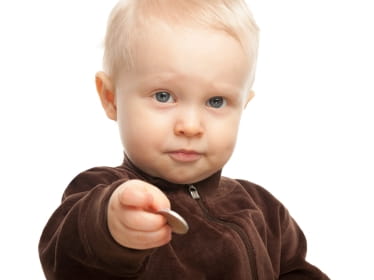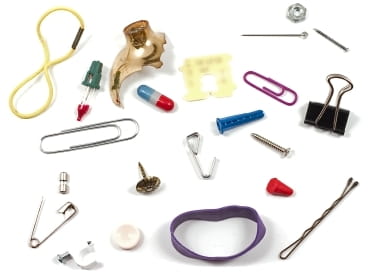Kids Will Swallow Anything Keeping Your Kids Safe from Unintentional Poisonings

The Bottom Line
Children will swallow anything they can reach. Most of the time, these objects pass through the gastrointestinal tract with no trouble; the object turns up in the child's stool. Sometimes, surgery is needed to remove the object(s). In one recent study, coins made up 80 percent of swallowed foreign objects that had to be removed by surgery.

The Full Story
Toothpicks. Twist-ties. Golf ball covers. Pins. Jewelry. Toys. Plastic bits. Hardware. Medical equipment. Batteries, of course. And coins - lots of coins.
Children who swallow non-food items sometimes need surgery to remove them. In a recent study, coins made up more than 80 percent of swallowed foreign bodies that required surgical removal. Button batteries have been identified as extremely dangerous for children to swallow. The range of other swallowed objects is eye-opening.
Most foreign bodies pass through the system without any symptoms or problems. Some can cause injury, especially button batteries, coins, and sharp objects. Children don't always have symptoms after swallowing something that's not food. Complaints of chest pain sometimes occur when a foreign body gets stuck in the esophagus, but not always. Coughing, gagging, vomiting, or refusing to eat are some other symptoms that may occur.
Parents often say, "My child would never swallow that." But - children will swallow anything that fits into their mouths and seems appealing, for whatever reason! Often, adults can't figure out what those reasons are.
The bottom line is that children explore their world by touch and taste. They will grab anything within reach. Anything in their hands goes into the mouth. This is normal behavior for toddlers.
It's best to prevent foreign body ingestions. Look at your home from your child's eye level. You'll spot items that should be moved – up high, out of sight and reach. And of course, it's important to watch young children closely. It's a challenge to keep children safe while allowing them to explore and learn, but we have to try.
If your child swallows something that's not food, don't wait for problems to appear. Call Poison Control at 1-800-222-1222. If it's a button battery, call the National Battery Ingestion Hotline at 800-498-8666 while you are on your way to the emergency room. Call your pediatrician if your child swallows a coin or other foreign object. Of course, if your child seems to be having any kind of chest pain, go to the emergency room right away. An x-ray may be needed to find the problem.
Rose Ann Gould Soloway, RN, BSN, MSEd, DABAT emerita
Clinical Toxicologist
Poisoned?
CALL 1-800-222-1222
Prevention Tips
- Look at your home from your child's eye level. You'll spot items that should be moved - up high, out of sight and reach.
- It's important to watch young children closely. It's a challenge to keep children safe while allowing them to explore and learn, but we have to try.
This Really Happened
A 9-year-old girl told her mother that she swallowed "one red coin". She had no symptoms; her mother brought her to the emergency room. An x-ray showed a foreign body in her esophagus. It looked like a button battery, though the child insisted she had swallowed only a coin. If a battery were stuck in the child's esophagus, she would be at risk of serious injury in a very short time.
While the pediatric surgeon was being called, the mother put her thumb and finger in the child's mouth, saying she was "trying to remove the battery". [This is not a recommended treatment; it could injure the throat, causing bleeding and trouble breathing.] The child gagged and vomited; two coins came up. They were a dime and a quarter stuck together, so on x-ray they had looked like a battery.
The child was sent home. The mother was told to bring the girl back if she developed trouble breathing or swallowing, or if she had abdominal pain.
Silverbert M, Tillottson R. Esophageal foreign body mistaken for impacted button battery. Pediatric Emergency Care. 2006;22:262-265.
For More Information
A Review of Pediatric Foreign Body Ingestion and Management, Seen Chung, MD, FRCPC, Vito Forte, MD, FRCS, Paolo Campisi, MSc, MD, FRCSC, FAAP
References
Poisoned?
CALL 1-800-222-1222
Prevention Tips
- Look at your home from your child's eye level. You'll spot items that should be moved - up high, out of sight and reach.
- It's important to watch young children closely. It's a challenge to keep children safe while allowing them to explore and learn, but we have to try.
This Really Happened
A 9-year-old girl told her mother that she swallowed "one red coin". She had no symptoms; her mother brought her to the emergency room. An x-ray showed a foreign body in her esophagus. It looked like a button battery, though the child insisted she had swallowed only a coin. If a battery were stuck in the child's esophagus, she would be at risk of serious injury in a very short time.
While the pediatric surgeon was being called, the mother put her thumb and finger in the child's mouth, saying she was "trying to remove the battery". [This is not a recommended treatment; it could injure the throat, causing bleeding and trouble breathing.] The child gagged and vomited; two coins came up. They were a dime and a quarter stuck together, so on x-ray they had looked like a battery.
The child was sent home. The mother was told to bring the girl back if she developed trouble breathing or swallowing, or if she had abdominal pain.
Silverbert M, Tillottson R. Esophageal foreign body mistaken for impacted button battery. Pediatric Emergency Care. 2006;22:262-265.
